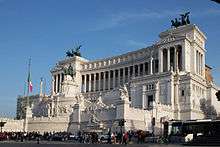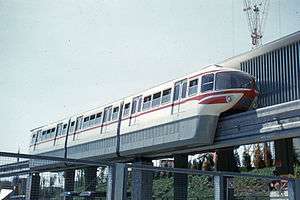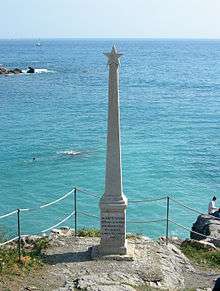Anniversary of the Unification of Italy
The anniversary of the Unification of Italy (Italian: Anniversario dell'Unità d'Italia) is a national day that falls annually on March 17 and celebrates the birth of the Italian state, which took place following the proclamation of the Kingdom of Italy on March 17, 1861.
| Anniversary of the Unification of Italy | |
|---|---|
150th anniversary of the Unification of Italy: the Rocca Estense of San Felice sul Panaro illuminated. From left to right Camillo Benso, Count of Cavour, Giuseppe Garibaldi, Victor Emmanuel II of Italy and Giuseppe Mazzini | |
| Official name | Anniversario dell'Unità d'Italia |
| Observed by | |
| Type | National |
| Significance | Birth of the Italian State in the form of the Kingdom of Italy in 1861 |
| Celebrations | Various events throughout Italy |
| Date | 17 March |
| Frequency | annual |
| First time | 17 March 1911 |
| Related to | Anniversary of the Liberation, Festa della Repubblica, National Unity and Armed Forces Day and Tricolour Day |
However, the complete unification of Italy took place only in the following years: in 1866 the Veneto and the province of Mantua were annexed, in 1870 Lazio and in 1918 Trentino-Alto Adige and Julian March. In this regard, the National Unity and Armed Forces Day was also established, which is celebrated annually on November 4, recalling the Italian victory in the First World War, a war event considered to complete the process of unification of Italy.
The anniversary of the birth of the Italian state was solemnly celebrated in 1911 (50 years), in 1961 (100 years) and in 2011 (150 years).
History
The anniversary of the unification of Italy recalls the promulgation of law no. 4671 of the Kingdom of Sardinia with which, on 17 March 1861, following the session of 14 March of the same year of the Chamber of Deputies in which the Senate of the Kingdom of Italy bill of 26 February 1861 was approved, Victor Emmanuel II of Savoy officially proclaimed the birth of the Kingdom of Italy, assuming the title of king of Italy for himself and his successors[1]:
The Senate and the Chamber of Deputies have approved; we have sanctioned and promulgate the following: Single article: King Vittorio Emanuele II assumes the title of King of Italy for himself and his Successors. We order that the present one, provided with the Seal of the State, be included in the collection of the acts of the Government, sending to anyone who is responsible for observing it and having it observed as the law of the State. From Turin on 17 March 1861
— Proclamation of the Kingdom of Italy
50th anniversary

In 1911, between March and April, the 50th anniversary of the birth of the Kingdom of Italy was celebrated with a series of exhibitions in Rome, Florence and Turin. In the latter city the International Exhibition of Industry and Labor was held. In the capital, whose mayor at the time was Ernesto Nathan, the ethnographic exhibition of the regions was organized (inaugurated on April 21st) and the International Review of Contemporary Art, the Altare della Patria, the bridge Victory Emmanuel II was inaugurated on the Janiculum, the lighthouse of the Italians of Argentina. In Florence the "Exhibition of the Italian portrait from the end of the 16th century to 1861" and the International Floriculture Exhibition was held from March to July. The material exhibited at the Rome Ethnographic Exhibition of 1911 was subsequently collected and is currently exhibited in the National Museum of Popular Arts and Traditions (MAT) in Rome.
The volume "The Three Capitals: Turin-Florence-Rome" written by Edmondo De Amicis in 1898 was published in support of the celebrations for the 50th anniversary.[2]
The director Luigi Maggi directed the film Nozze d'oro, based on a history of the Risorgimento, making an ideal parallel between the 50th anniversary of the unification of Italy and the 50th wedding anniversary of a bersagliere who fought in the Second Italian War of Independence; the film's title plays on the fact that this wedding anniversary is traditionally known as a "golden wedding".
On 1 May 1911 a series of stamps was issued to commemorate the event known as the 50th anniversary of the Unification of Italy.
The Accademia dei Lincei, under the guidance of Pietro Blaserna, published the work "Cinquant'anni di storia italiana" in three volumes describing the political, economic and civil life history of Italy from 1861 to 1911.[3]
These celebrations were the only ones in which the surviving veterans of the events linked to the Second Italian War of Independence and the Expedition of the Thousand took part.
100th anniversary

The celebrations of the centenary began in 1959 with the visit to Italy of General Charles de Gaulle, from 23 to 27 June, to celebrate the memory of the Franco Piedmontese alliance that allowed the victorious Second Italian War of Independence, which constituted the spring from which two years later national unification took place. During this visit, military magazines and demonstrations were organized on the battlefields of Magenta, Solferino and San Martino, and a visit to the Altare della Patria in Rome.[4]
In 1961, on the occasion of the 100th anniversary of the Unification of Italy, three exhibitions were organized in Turin: the Historical Exhibition of the Unification of Italy, the Exhibition of Italian Regions and the International Labor Exhibition also known as Expo 61.[5]
Roberto Rossellini, author of numerous historical period films, directed two films centered on the Risorgimento: the celebratory Garibaldi, in which he reconstructs the expedition of the Thousand, and the more intimate Vanina Vanini, set in the times of the Carbonari uprisings.
150th anniversary
On the occasion of the 150th anniversary on 17 March 2011, celebrations were held throughout Italy and a national holiday was proclaimed with schools, offices and suspended work activities. Moreover, in order to avoid burdens on public finance and private companies, the juridical and economic effects of the suppressed holiday of November 4th were shifted to that date, or each employee had to deduct a day of leave required by the annual vacation sum.
The places were chosen by the guarantors in the meeting of 28 September 2009, as the first aspect to revitalize and enhance, given their close link with the history of Italy. The key cities of this initiative are Turin, Milan, Naples, Genoa, Venice, Palermo, Florence, Bologna, Rome and other cities.

The celebrations for the 150th anniversary began on 5 May 2010 in Quarto dei Mille, with the participation of the President of the Italian Republic Giorgio Napolitano, the President of the Chamber of Deputies Gianfranco Fini, the President of the Senate Renato Schifani, the ministers Ignazio La Russa and Sandro Bondi, and other authorities. The town was chosen after a proposal by Carlo Azeglio Ciampi because it was from Quarto dei Mille that the Expedition of the Thousand, headed by Giuseppe Garibaldi, began on 5 May 1860.
On 11 May 2010, President Napolitano attended in Marsala a historical reenactment of the arrival of the Thousand in the city, after which he laid a wreath at the monument dedicated to the event. Napolitano went later to Salemi and Calatafimi to honor, together with Ignazio La Russa, the fallen of the battle of Calatafimi, which took place on 15 May 1860.[6]
The celebrations came alive on 17 March 2011, on the occasion of President Napolitano's visit to Turin, who proclaimed the start of the celebrations by lighting the tricolor ring around the Mole Antonelliana. For the occasion, the Turinese exhibited over 100,000 tricolor flags in the windows. During the three-day visit, the 'Fare gli Italiani' exhibitions (curated by Walter Barberis and Giovanni De Luna) and 'Stazione futuro' (curated by Riccardo Luna) at the OGR Officine Grandi Riparazioni in Turin, and 'La Bella Italia' (curated by Antonio Paolucci) at the Palace of Venaria were inaugurated. Over 2,000,000 visitors attended the Turin celebrations.
With the law no. 222 of 23 November 2012 concerning the "Rules on the acquisition of knowledge and skills in the field of Citizenship and Constitution, and on the teaching of the national anthem in schools", the institution of the National Unity Day, the Constitution, the anthem, and the flag were approved.
The Republic recognizes the 17th of March, the date of the proclamation of the Unification of Italy in Turin in the year 1861, as "National Unity Day, of the Constitution, of the anthem and of the flag", in order to remember and to promote, in the context of a widespread didactics, the values of citizenship, the foundation of a positive civil coexistence, as well as to reaffirm and consolidate the national identity through remembrance and civic memory
— Italian Parliament, art. 1, paragraph 3, law 23 November 2012, no. 222
See also
Citations
- "Torino, 17 marzo 1861: la proclamazione del Regno d'Italia". 150anni-lanostrastoria.it. Retrieved 9 February 2016.
- "Il Cinquantenario del 1911" (in Italian). Archived from the original on 11 February 2011. Retrieved 18 March 2011.
- See p. 54 in Raffaello Morghen L'Accademia Nazionale dei Lincei nel CCCLXVIII anno dalla sua fondazione, nella vita e nella cultura dell'Italia unita, Accademia Nazionale dei Lincei, Roma, 1972 online Archived 2012-10-31 at the Wayback Machine
- "Le voyage officiel en Italie du général de Gaulle (23-27 juin 1959)" (in French). Retrieved 25 September 2017.
- "Per conoscere in dettaglio la manifestazione si può visitare il sito" (in Italian). Retrieved 25 September 2017.
- "Verso il 2011" (in Italian). Archived from the original on 9 October 2010. Retrieved 12 March 2011.
| Wikimedia Commons has media related to 150th anniversary of the Italian unification. |